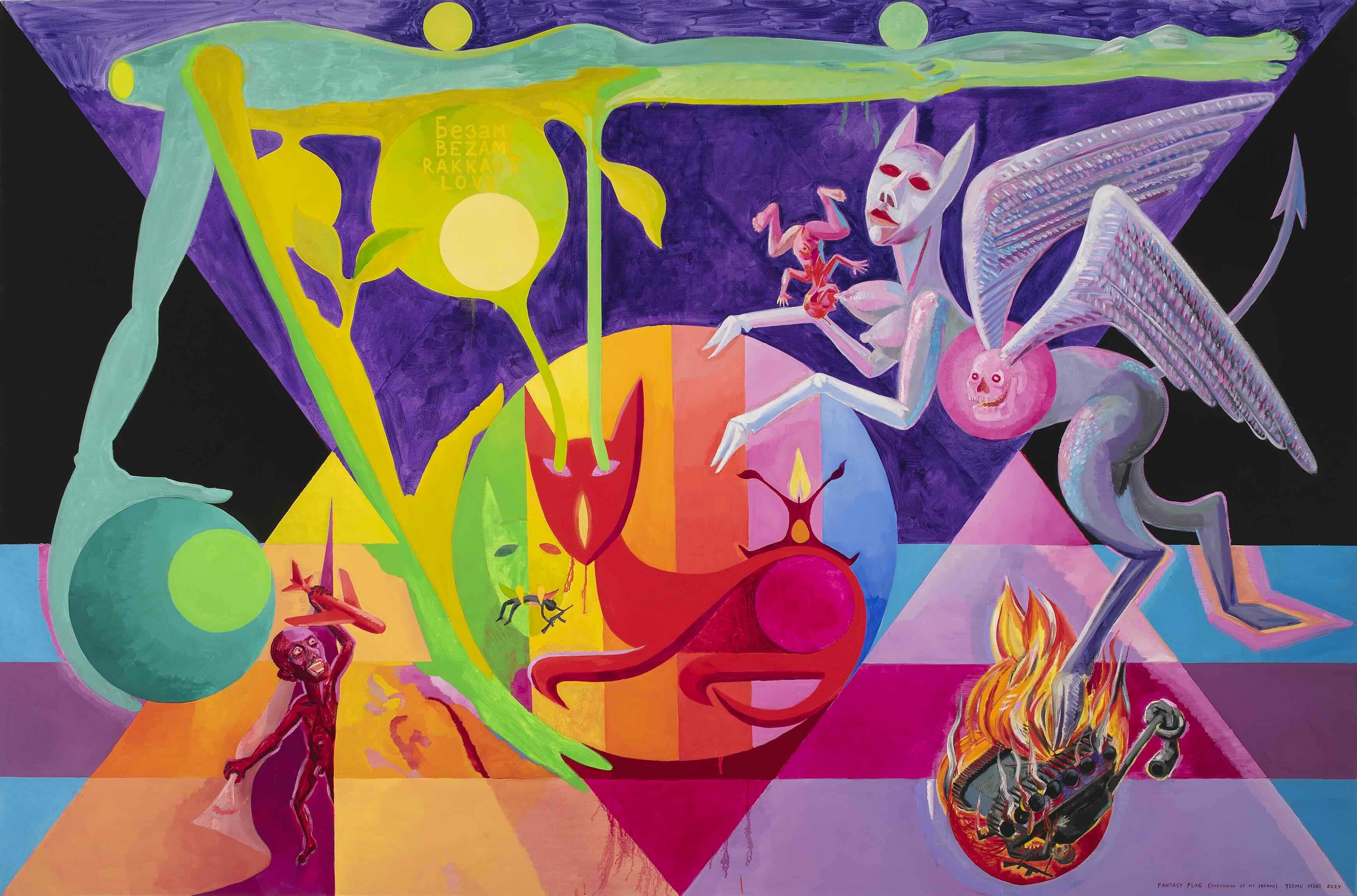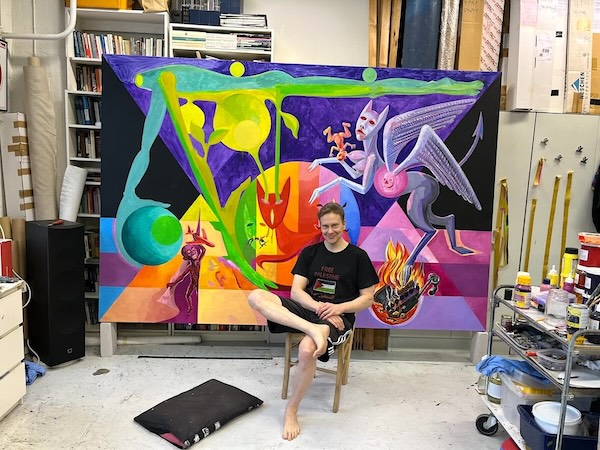
Fantasy Flag (Chechnya of My Dreams)
An extract from the multipartite Do You Remember Chechnya?.
First shown in DO YOU REMEMBER CHECHNYA? (2) exhibition, 2024.
Teemu Mäki
2024. Oil on canvas. 200 x 300 cm.
| The painting
is an informal fantasy, based on the flag that Chechnya used during its
years of independence in 1990s. My own relationship with nation-states
and flags is contradictory. Nation-state is a bad, but sometimes useful
idea. It’s not reasonable to claim that a piece of land belongs to a certain ethnic group or people speaking a certain language. Humans are not genuinely divided into strictly separate nationalities, races or other equivalent groupings. And humans are not chained into any piece of land through their ancestors or history. When national identity and the demand for nation’s own piece of land is created, based on language, religion or blood-relations, it’s also the starting point of segregation: the outsiders must be expelled or given the status of second-grade citizens. Some insiders are also discriminated, because those who radically differ from the national identity or criticize the current features of it are easily labeled as traitors. Nationality is just a mental image. Groups of people constantly move and merge with each other. That’s why each state should treat all persons within its borders equally well, no matter what their background, language and other features are. On the other hand, national identity and the demand for own land is often for oppressed people the only way to preserve their traditions and the only way to freedom. For a long time people living in the area that’s now called Finland were second-rate citizens under the rule of Sweden, then Russia. From that rose the need to create a fantasy about Finland and the Finnish people — to fight for freedom. Chechens, Palestinians, Kurds and many other groups of people have the same need today, since it’s hard for them to find a home anywhere. I put the Chechens here into the same category with Palestinians and Kurds even though the current Chechnya is a partly autonomous state within Russia, because Chechens there are not free, but at the mercy of a feudal lord that serves Russia. That’s why so many Chechen have migrated or escaped abroad. Most of them dream of return and of independent Chechnya. If and when Chechnya becomes independent again, I hope it doesn’t become a nation-state built only on one ethnic group, one religion and one language, but a democratic and multicultural society. I looked at the flag of Chechnya and played like a child: what would be my flag if I painted it from the flag of Chechnya? I’m not ridiculing the flag of Chechnya, I’m encouraging Chechens to keep on fighting for freedom. I also encourage every person to make a flag of their own. |
Fantasialippu (Unelmieni Tšetšenia)
Kuuluu moniosaiseen teokseen Muistatko Tšetšenian?
Ensimmäisen kerran esillä MUISTATKO TŠETŠENIAN? (2) -näyttelyssä 2024.
Teemu Mäki
2024. Öljy kankaalle. 200 x 300 cm.
| Maalaus
on vapaamuotoinen fantasia. Se perustuu lippuun, jota itsenäinen
Tšetšenia käytti 1990-luvulla. Oma suhteeni kansallisvaltioihin ja
niiden lippuihin on ristiriitainen. Kansallisvaltio on huono, mutta
joskus hyödyllinen idea. Ei ole järkevää väittää minkään maa-alueen kuuluvan jollekin tietylle etniselle ryhmälle tai tiettyä kieltä puhuvalle ryhmälle. Ihmiset eivät oikeasti jakaudu tiukasti erillisiin kansoihin, rotuihin tai muihin vastaaviin, eivätkä ihmiset ole sidottuja mihinkään maapalaan sukunsa tai historiansa kautta. Kun luodaan kielen, uskonnon tai verenperinnön pohjalta kansallinen identiteetti ja vaatimus omasta maasta, aloitetaan samalla syrjintä: ulkopuoliset on karkotettava tai heille on annettava alempi status. Myös oman kansan jäseniä aletaan syrjiä, sillä kansallisesta identiteetistä kovasti poikkeavat tai tämänhetkistä kansallista identiteettiä kritisoivat henkilöt leimataan helposti pettureiksi. Kansa on oikeasti vain mielikuva. Ihmisryhmät liikkuvat ja sekoittuvat toisiinsa jatkuvasti. Siksi jokaisen valtion pitäisi kohdella kaikkia alueellaan eläviä ihmisiä yhtä hyvin heidän taustastaan, kielestään ja muista ominaisuuksistaan riippumatta. Toisaalta, kansallinen identiteetti ja vaatimus omasta maasta on alistetuille ihmisille usein ainoa keino säilyttää omia traditioitaan ja ainoa reitti vapauteen. Nykyisen Suomen alueella asuvat ihmiset elivät pitkään toisen luokan kansalaisina Ruotsin ja Venäjän alaisuudessa. Siksi oli tarpeen luoda fantasia Suomesta ja suomalaisuudesta — jotta voitiin tavoitella vapautta. Sama tarve on tälläkin hetkellä myös tšetšeeneillä, palestiinalaisilla, kurdeilla ja monilla muilla ihmisryhmillä, joiden on vaikea löytää mistään kotia. Laitan tässä tšetšeenit samalle listalle palestiinalaisten ja kurdien kanssa, sillä vaikka Tšetšenia on tällä hetkellä osittain itsenäinen osa Venäjää, eivät sen asukkaat ole vapaita, vaan Venäjää palvelevan feodaaliherran armoilla. Siksi suuri osa tšetšeeneistä on joutunut muuttamaan tai pakenemaan muihin maihin. Useimmat heistä, haaveilevat paluusta ja itsenäisestä Tšetšeniasta. Jos ja kun Tšetšenia joskus taas itsenäistyy, toivon ettei siitä tule vain yhden etnisen ryhmän, yhden uskonnon ja yhden kielen varaan rakennettua maata, vaan demokraattinen ja monikulttuurinen yhteiskunta. Katsoin Tšetšenian lippua ja leikin leikin: millainen olisi oma lippuni, jos maalaisin sen Tšetšenian lipun pohjalta? En tee pilaa Tšetšenian lipusta, vaan kannustan tšetšeenejä jatkossakin tavoittelemaan vapautta. Kannustan myös jokaista ihmistä tekemään itse oman lippunsa. |
